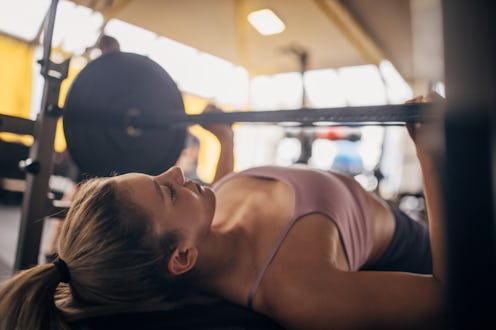Fitness
What Muscles Does The Bench Press Work? Fitness Pros Explain
The lowdown on the classic upper body move.

In the realm of weight lifting exercises, the bench press is one of the most classic moves fitness aficionados regularly turn to. And that’s for good reason: It calls on many different muscle groups within the arms and back to work together, making it a great addition to your upper body strength routine.
If you’re not familiar, the bench press is an exercise where — surprise! — you lie on a bench and press either a barbell or dumbbells vertically above your chest, explains TJ Mentus, an ACE-certified personal trainer. Doing it for the first time? Heather Hart, an ACSM-certified exercise physiologist, recommends choosing a weight that’s challenging to press up by the last three to four reps in a given set, but not so challenging that your form falls apart. “If you have to force the last few reps with poor form, you are lifting too heavy and need to back down on weight,” she tells Bustle. It’s also important to make sure the bar is set at the proper height. “When you lift the bar up, you should only need to slightly extend the elbows straight,” Mentus explains.
To really strengthen your muscles, consider doing bench presses two to three times a week, aiming for three to four sets of eight to 12 reps each time. Hart also recommends using a spotter, aka an experienced friend or personal trainer who stands by and helps out if needed. It is a complicated move, after all. Read on for how intel on all the muscles you’ll work when you do a bench press along with tips on how to do the exercise properly.
All The Muscles A Bench Press Works
It’s not just an arm exercise — these are all the muscles that get an amazing workout as you move through a bench press.
1. Pectoralis Major
The bench press targets the pecs — the pectoralis major and pectoralis minor — muscles in the chest. According to Hart, these muscles play a role in the "pushing" movement that presses the weight against gravity from your chest back to the starting position.
Mentus says you’ll feel your pecs contract as you do the move. “You should get the biggest squeeze at the top of the movement, but they will do the most work at the bottom as you begin to press the bar up again,” he says.
2. Triceps
According to certified personal trainer Robert Dodds, the triceps also engage throughout the bench press. “Your triceps take over as you get near the top to finish the movement and lock the weight out,” he tells Bustle. “These are the muscles on the back of your arm that are involved in all pushing exercises.”
3. Anterior Deltoids
You’re also working anterior deltoids, aka the small muscles on the front of your shoulders that help move your arms forward. “These assist in the pushing movement,” Dodds explains.
4. Serratus Anterior Muscle
The serratus anterior muscles, located on the sides of your chest on your ribs, will get a workout, too. “The serratus anterior is involved by supporting your shoulder girdle during pressing and pushing exercises,” says Dodds. “It takes some of the strain off your rotator cuff, allowing you to lift heavier loads.”
5. Latissimus Dorsi
As the weight is lowered back down, the latissimus dorsi, or lats, in your back will light up to help decelerate the bar or dumbbells, Dodds says. This is why a bench press is considered a compound exercise: While the bench press may not work the lats — or the core, or the biceps — directly, all of these muscles do engage to hold you stable while you complete the exercise.
How To Do A Bench Press
Here, Hart explains how to do a bench press using proper form so that you can work all the right muscles.
- Lie on your back on a flat bench, making sure you have five points of contact: The back of your head, your upper back and shoulders, and your lower back/butt should all be touching the bench, and both of your feet should be firmly planted on the floor.
- Position yourself on the bench under the racked barbell. Scoot your body so that your eyes are directly below the bar.
- Place your hands on the bar with a closed, pronated grip slightly wider than shoulder-width apart. Make sure your arms are evenly spaced across the length of the bar. Hint: You can use the marks in the bar to ensure you’re grasping the bar evenly.
- Once you’re ready, remove the bar from the racked position so that it’s hovering over your chest, with your arms fully extended at the elbow.
- In a slow, controlled movement, lower the bar towards your chest, bending at the elbows. Your elbows should move down past your torso and away from your body, while your forearms should remain parallel to each other but perpendicular to the floor.
- Lower the bar until it lightly touches your chest. Don’t let it bounce off of your chest!
- Keeping your wrists stiff and forearms perpendicular to the floor and parallel to each other, push the bar back towards the ceiling in an upward motion until your elbows are fully extended.
- Repeat for the desired number of repetitions.
Studies referenced:
Melani, A., Gobbi, G., Galli, D., Carubbi, C., Masselli, E., Neri, L. M., Giovinco, G., Cicchella, A., Galuppo, L., Presta, V., Vaccarezza, M., Vitale, M., & Mirandola, P. (2019). Muscle Activation in Traditional and Experimental Barbell Bench Press Exercise: A Potential New Tool for Fitness Maintenance. Sports (Basel, Switzerland), 7(10), 224. https://doi.org/10.3390/sports7100224.
Sources:
TJ Mentus, ACE-certified personal trainer
Heather Hart, ACSM-certified exercise physiologist
Robert Dodds, certified personal trainer
This article was originally published on